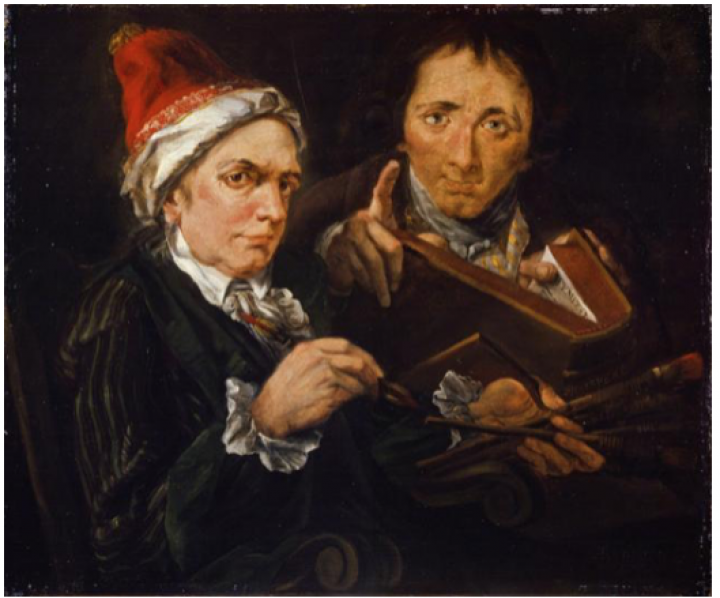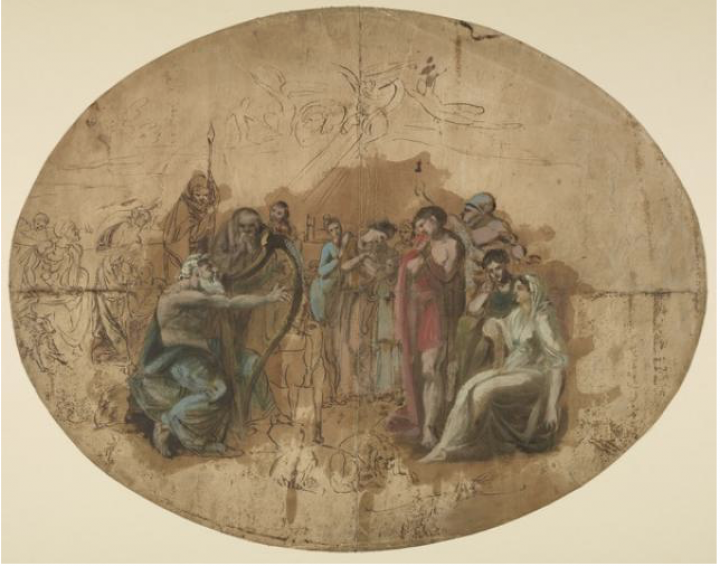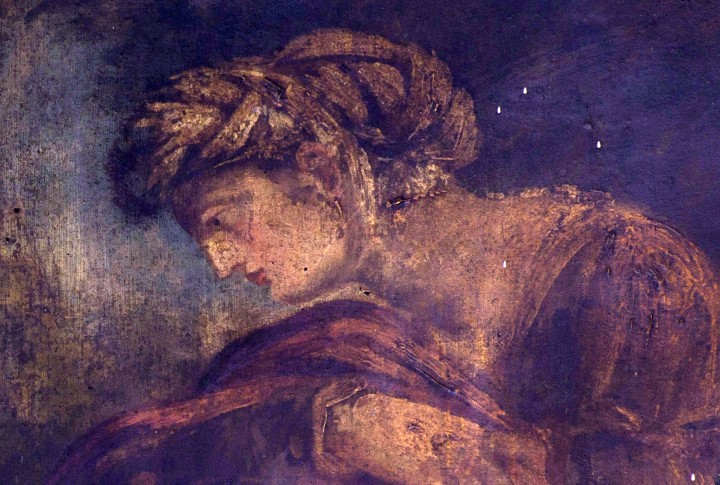Scottish Art News
Latest news
Magazine
News & Press
Publications
Alexander Runciman's The Ascension
By Duncan MacMillan, 01.05.2019

More than 50 years ago, when I first came to teach in Edinburgh, the plan was that I would also pursue a London University PhD on Picasso with my former tutor, Anthony Blunt. However, a chance discovery quite unexpectedly turned my interests to Scottish art, a wholly new direction which I have followed ever since.
For me, it all began while browsing in the library, where I came across a reference to Alexander Runciman’s painting of The Ascension in St Patrick’s Church in Edinburgh’s Cowgate. Like Runciman’s more famous painting of Ossian’s Hall at Penicuik House, destroyed by a major fire which gutted the house in 1899, The Ascension too was believed to have been lost. My curiosity piqued, I went to St Patrick’s and realised that if it had been painted on the still-intact fabric of the church, it could not have been destroyed. After some tests, sure enough, under a good many coats of paint and adorned with a plaster dove in glory, Runciman’s painting had indeed survived. There and then, I decided to abandon Picasso and follow Alexander Runciman, transferring my PhD from London to Edinburgh University. My decision was, I am afraid, much to Anthony Blunt’s disgust.
That was perhaps understandable. Alexander Runciman was totally unknown. Indeed, with the honourable exception of Ellis Waterhouse (author of the landmark Painting in Britain 1530-1790), the concept of Scottish art effectively did not exist in the eyes of the art establishment. A catalogue from the time of a survey exhibition of ‘British’ art, found in an Amsterdam second-hand bookshop, provides a vivid illustration of this mindset. It includes those two great Scottish artists, Ramsay and Raeburn. It also has a helpful map. In it, Britain ends at Berwick-upon-Tweed. Further north was terra incognita.
 Alexander Runciman, The Blind Ossian Singing and Accompanying himself on the Harp, c. 1772. National Galleries of Scotland, David Laing Bequest to the Royal Scottish Academy transferred 1910.
Alexander Runciman, The Blind Ossian Singing and Accompanying himself on the Harp, c. 1772. National Galleries of Scotland, David Laing Bequest to the Royal Scottish Academy transferred 1910.
Trained in Edinburgh as a decorative painter in the established firm of James Norie & Co, Runciman went to study in Rome in 1767. Accompanied by his talented younger brother John, he was funded by an advance payment from Sir James Clerk of Penicuik for the proposed decoration of the saloon of his new house at Penicuik, designed by Runciman’s close friend and companion in Rome, John Baxter. John Runciman died in Naples early in 1769, but Alexander returned to Scotland in 1771 and completed his contract with Sir James in 1772. What had been planned as a decorous Palladian ceiling decoration had, however, evolved in Rome into the vivid and dramatic scheme that came to be known as Ossian’s Hall. From the surviving evidence – in the watercolour of Ossian’s Hall illustrated, for instance – it is clear that it was truly remarkable. Hugh Blair was a champion of the bard Ossian, describing the supposedly primitive poetry attributed to him as ‘shooting wild and free’. Runciman’s painting seems to have captured exactly that sense of uninhibited, primitive freedom.
In Rome, his ambitions had been fostered by the example of Gavin Hamilton and by his friendships with James Barry, Henry Fuseli and Tobias Sergels. Barry’s Progress of Human Culture series of paintings in London’s Royal Society of Arts clearly sprang from the same inspiration as Ossian’s Hall, but it is tame in comparison. It also took years to paint. Runciman, on the other hand, painted Ossian’s Hall and an adjacent staircase with scenes from the life of St Margaret of Scotland between July and September 1772. There were 21 separate compositions altogether and the central oval of Ossian singing was 24 feet across. The whole work was done in a fever of creativity: imitation of the primitive, spontaneity, conventions of finish abandoned in favour of imaginative freedom of expression and creative excitement; it was truly modern. Ossian’s Hall was painted in oil directly onto white primed plaster, which evidently gave it great brilliance.
This was also the technique used in The Ascension, painted the following year in the apse of the magnificent new Episcopalian Chapel opened in Edinburgh in 1774. The architect was again John Baxter. By 1818, however, the Episcopalian congregation had migrated to Edinburgh’s New Town. The church was sold to the United Presbyterians who painted out ‘The Ascension’. In 1856, they in turn sold the building to the Roman Catholics and it has been the parish church of St Patrick ever since, though it has changed considerably. A large new chancel was added on the north side of the building, rendering the original apse redundant. Baxter’s design also included a grand portico. This was never built, but in 1929 a neo-classical facade was added by Reginald Fairlie.
The Ascension, probably the first public religious painting done in Scotland since the Reformation and certainly the grandest, is painted on an elliptical half-dome, 24 feet across. It is thus on the same scale as Ossian’s Hall. We have no certain drawings for it and no visible record of what it looked like, though a brief description given by the artist in a letter to his friend, the antiquarian George Paton, indicates that it has the apostles beneath and Christ rising in glory above them.
 Detail of the Woman of Samaria, from Alexander Runciman's murals. Photographed by Colin McLean.
Detail of the Woman of Samaria, from Alexander Runciman's murals. Photographed by Colin McLean.
This composition was, however, only the main feature of a scheme that embraced the whole apse. Beneath The Ascension are four subsidiary paintings – Moses, Elijah, Christ and the Woman of Samaria and The Return of the Prodigal Son. These were not painted over and, though now in dire need of restoration, have always been visible. The prophets Moses and Elijah are appropriate supporters to the Ascension, having been present at the Transfiguration which foreshadowed it. The two narrative scenes, however, are good Episcopalian propaganda. Christ and the Woman of Samaria represents the Episcopal church among the heathen (Presbyterian Scotland) and The Return of the Prodigal Son is the return of a prodigal Scotland to its true, parent church.
These four large pictures, though in such a poor state, nevertheless give a vivid idea of what the main painting must be like and indeed reveal the freedom and vigour of execution that was evidently so distinctive in Ossian’s Hall. Tests reveal that all this was also framed by vivid secondary decoration of swags and garlands, with images of the apse in the late 19th century showing part of this still survived at that time above later ornaments. The secondary decoration in Ossian’s Hall was likewise elaborate and brilliant in colour. Recovered, the whole scheme at St Patrick’s would give us back an astonishing and precocious masterpiece.
In 1771, Henry Fuseli wrote that Runciman ‘is the best painter among us here in Rome’ and when, more than 30 years later, a young Scot, David Wilkie, turned up in his class at the Royal Academy, one of the first things Fuseli asked was if he had seen Ossian’s Hall. Fuseli knew that Runciman alone, among the young artists forging a new kind of art in Rome, had at his command all the expressive possibilities paint offered in colour and freedom of handling. These qualities were best seen in his large-scale work, but with his masterpiece Ossian’s Hall lost, it makes the recovery of The Ascension so important.
Over the years, I have promoted various attempts to recover The Ascension, but it soon became clear that with the methods available at the time, the damage would be too great – the painting would be destroyed even as we recovered it. A few years ago, however, we embarked on a new exploration. Two conservators, Owen Davidson and the late Sally Cheyne, devised a method that, while extremely tricky, would nevertheless uncover the painting without damage. With the enthusiastic support of the church, its parish priest and its congregation, we have recently formed the Runciman Apse Trust to raise the funds and oversee the recovery of The Ascension, as well as the restoration of the other paintings and of the decoration in the apse. Fundraising can now begin and I hope, in the not too distant future, to see this great painting restored in the full glory of the original scheme which once framed it.
Duncan Macmillan is a Professor Emeritus at the University of Edinburgh, an art critic and art historian. For more details on the restoration of Runciman's Ascencion, visit the Runciman Apse Trust




